Logical fallacies are flaws in reasoning that weaken or invalidate an argument. Whether they’re used intentionally or unintentionally, they can be quite persuasive. Learning how to identify fallacies is an excellent way to avoid being fooled or manipulated by faulty arguments. It will also help you avoid making fallacious arguments yourself!
Scroll through to learn to identify some of the more common fallacies. Once you can recognize them, you’ll see them everywhere!
A note on how to use this post: This page is a resource of the most common logical fallacies, and is not intended to be read from top to bottom. Feel free to share the graphics to help educate others about errors in reasoning. Hopefully together we can encourage more productive (and logical!) dialogue.
Ad hominem
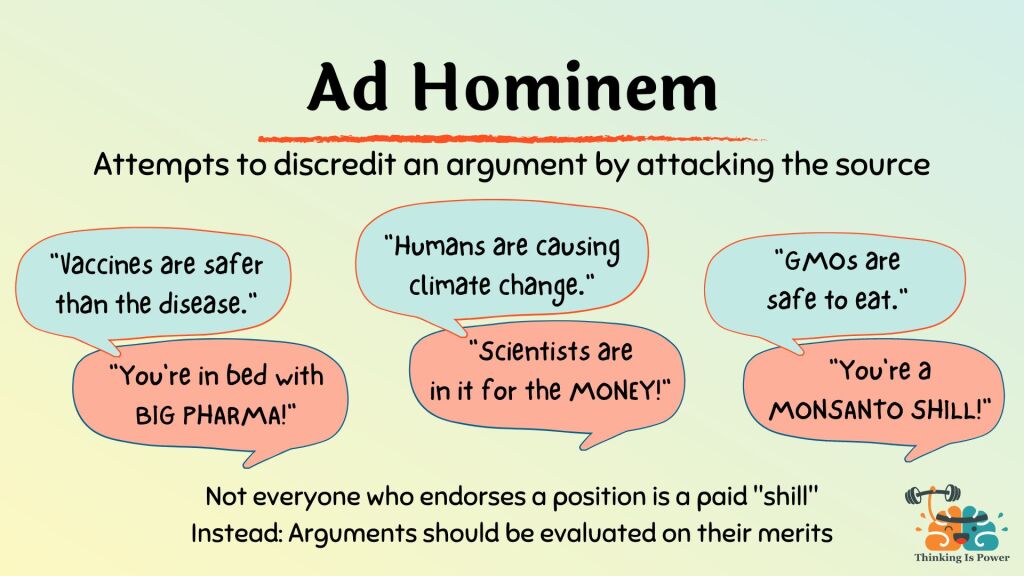
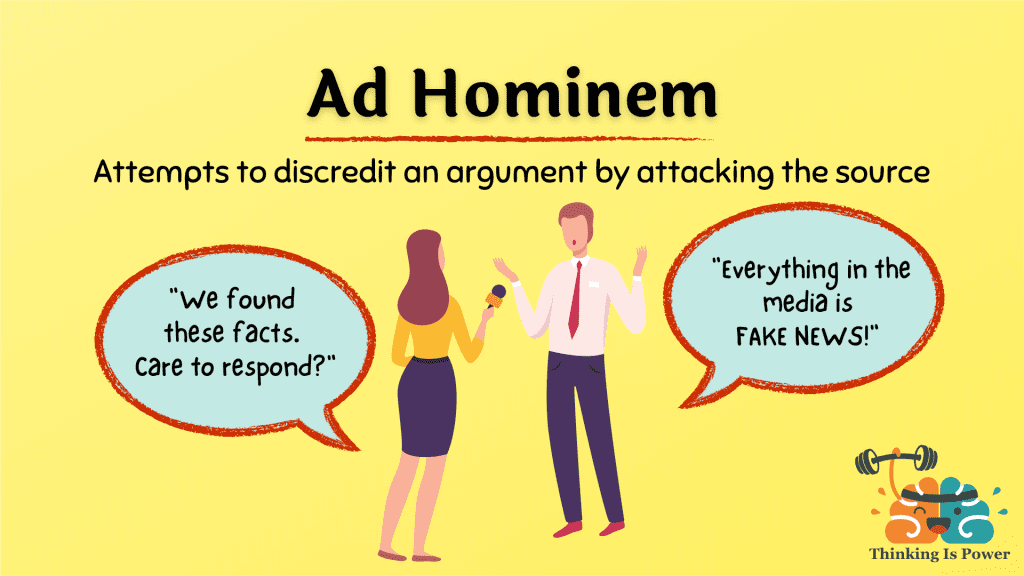
Other names: Personal attack, name-calling
Definition and explanation: Latin for “to the person,” the ad hominem fallacy is a personal attack. Essentially, instead of addressing the substance of an argument, someone is attempting to discredit the argument by attacking the source.
The ad hominem is one of the most common logical fallacies. While it can take many forms — from name calling and insults, to attacking a person’s character, to questioning their motives, to calling them hypocrites — any argument that targets the source, rather than the argument, is an ad hominem. Unfortunately, ad hominem arguments are often quite effective because they appeal to people’s emotions and biases.
No matter the form, the ad hominem is fallacious because the source of the argument is irrelevant to the substance of the argument. It’s a diversion tactic.
How to counter: While there are many sub-types of ad hominem fallacies, identifying the exact kind is less important than recognizing someone is attempting to divert from your argument back onto you in some way. It might be tempting to respond to their attack in kind. However, by resorting to an ad hominem fallacy, an arguer is essentially admitting they lack a substantive argument. Instead of letting them get under your skin, point out the irrelevance of their argument. Or, you could ignore it and move on!
Anecdotal Fallacy
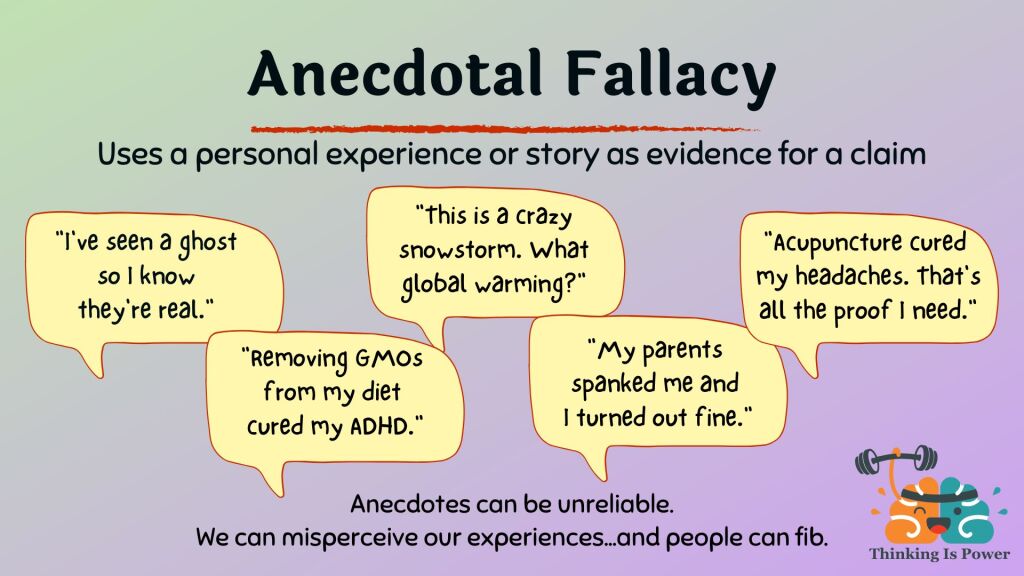
For a more detailed explanation: Four ways your personal experiences can lead you astray
Definition and explanation: The anecdotal fallacy uses a personal experience or story as evidence for a claim.
Many people think personal experiences provide the best kind of evidence. “We’ll believe it when we see it!” But anecdotes are infamously unreliable.
- We can misperceive our experiences.
While there is an objective reality outside of our heads, our perception of that reality is a subjective interpretation. Our brains filter and interpret stimuli and fill in any gaps based on expectations. Yet even though our perceptions are flawed and incomplete, we’re convinced we “know” what we saw or experienced.
For example, eyewitness testimony tends to be among the most valued forms of evidence in a trial…yet it’s also the leading cause of wrongful convictions.
- Anecdotes aren’t controlled.
Imagine you have a headache and take a supplement. Your headache gets better! Was it due to the supplement?
The correct answer is: You don’t know. Any number of things could’ve been the cause. (And also…nearly all headaches go away on their own.) That’s why treatments are tested in carefully controlled trials that compare the treatment to a placebo.
- Anecdotes often aren’t typical.
Small samples are often not representative of normal conditions. Yet because the human brain doesn’t intuitively grasp probabilities we rely on stories or experiences when deciding what to believe.
Consider the following examples: My cousin was mugged in Sydney, so Australia is dangerous. Toyotas are unreliable because I once had a Toyota that was always in the shop. This winter seemed really cold, so there’s no global warming.
- Finally, people aren’t always truthful.
Did that person on social media REALLY lose weight eating bacon and ice cream? Did your dad exaggerate his “ghost” story? Did the person in the testimonial really “cure” their acne with the supplement?
It’s the hard truth, but people can lie.
The bottom line: Anecdotes aren’t good evidence.
How to counter: First, it’s important to not fall for this fallacy yourself. Remember that your brain prefers stories – especially vivid and emotional ones – to data. So if your goal is to align your beliefs with reality, be skeptical about the conclusions you can draw from your lived experiences and be humble enough to admit that you might be wrong.
In conversations with others, be empathetic. Most people are convinced that anecdotes are a sure-fire way of knowing what’s true, and it can be quite difficult to convince someone that they might be wrong. We don’t like to admit that we can be fooled, especially by ourselves. If the conversation allows, gently explain why anecdotes aren’t good evidence.
Appeal to authority
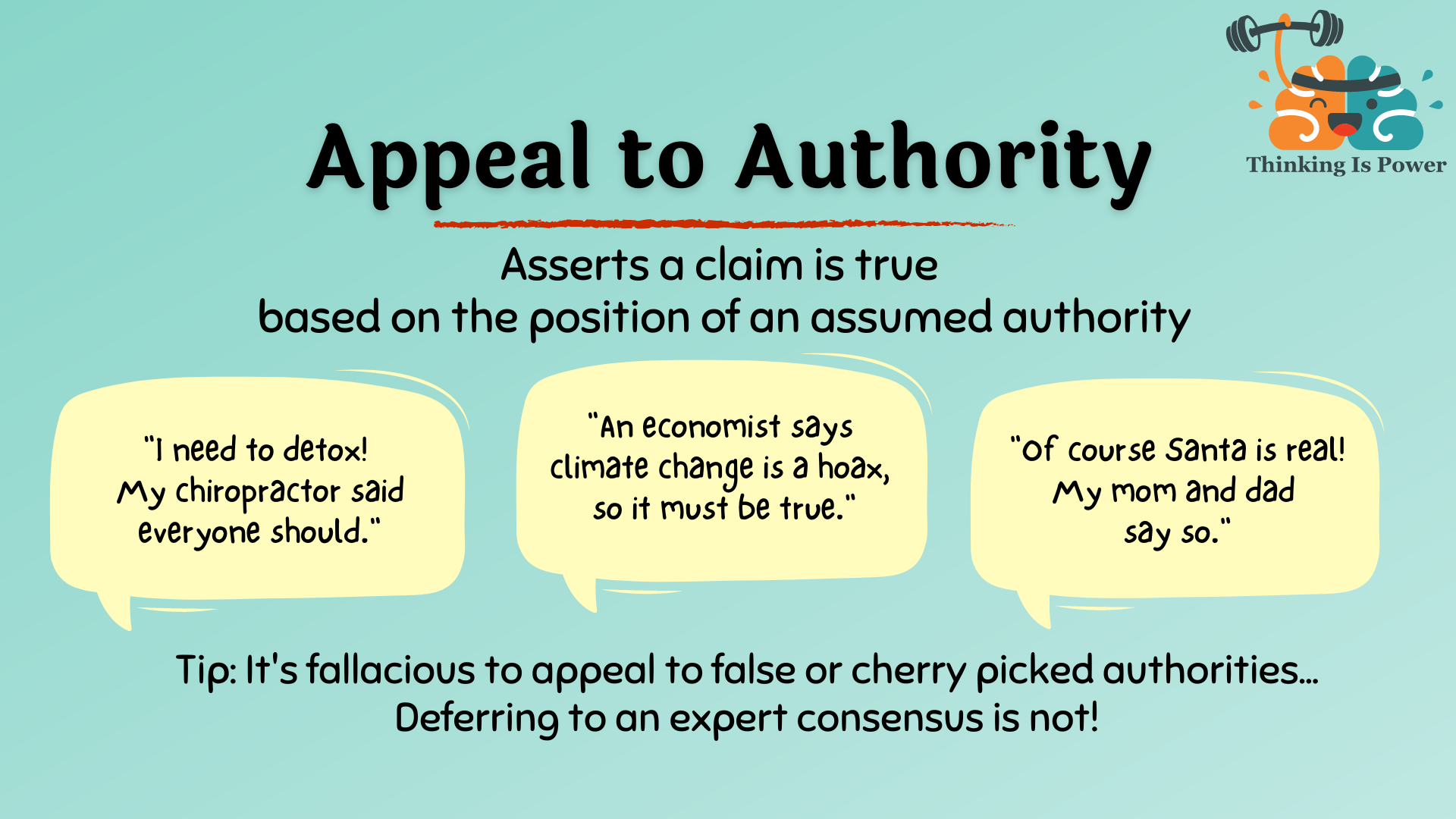
Other names: Argument from authority, appeal to false authority
Definition and explanation: The appeal to authority fallacy claims that something is true based on the position of an assumed authority.
This fallacy is very common, and can be quite tricky, so it’s important to be able to recognize it and understand when it is and isn’t fallacious. In general, arguments should have evidence, and authorities aren’t evidence. However, since it’s impossible for any of us to verify every single thing ourselves, we often rely on experts. For example, we trust mechanics to fix cars, doctors to treat diseases, and pilots to fly planes. Due to their experience, training, and knowledge, experts are better able to evaluate evidence related to their areas of expertise. Therefore, citing actual experts isn’t an appeal to authority. However, citing authorities can only support an argument, not prove it, as experts can be wrong… though they are more likely to be right than non-experts.
An appeal to authority IS fallacious when:
- The “authority” isn’t an expert. This is probably the most common form of the fallacy, and easiest to spot. For example, Jenny McCarthy isn’t a vaccine expert, the Food Babe isn’t a nutrition expert, and Tom Brady isn’t a health expert, yet all use their celebrity to promote products or services. Or consider a senator who says climate change is a hoax, or your math teacher who claims aliens built the pyramids. The point is, these supposed “authorities” aren’t experts, so their testimony doesn’t hold any weight.
- The “authority” is an expert in another area. The opinion of experts is only relevant within their area of expertise. For example, a heart surgeon is not an expert in climate change and a physicist is not an expert in cancer. An advanced degree does not make someone an expert in all areas, and there will always be someone with a doctorate who has crackpot ideas. So when an authority makes a claim, it’s important to ask whether they are in a position to make such a claim.
- The “authority” makes a claim that is contrary to the expert consensus in that particular area. The expert consensus is the collective agreed-upon knowledge of experts in a specialized field. As non-experts, the consensus is the most reliable form of knowledge. However, it can be difficult for the average person to sort out, especially when someone who appears to be a legitimate expert makes claims contrary to the consensus. But if you’re cherry picking an authority with a minority position to make an argument, but neglecting the authority of the expert consensus, you’re committing an appeal to authority.
The bottom line is that if you’re going to cite an authority to make an argument, it needs to be an actual expert on the topic at hand, and one who is in line with the expert consensus, otherwise you’ve committed an appeal to authority fallacy.
How to counter: We’re often unaware of how many of our beliefs originated from trusted authority figures, such as teachers, parents, and various online sources. Only when we have to defend a belief do we realize how much of our knowledge we’ve outsourced… which can result in us committing an appeal to authority fallacy. Get in the habit of evaluating authorities to determine if they have the expertise to make various claims. And empathize with others who may not yet know how to discern who is and isn’t a reliable authority.
To learn more: The Logic of Science: Appealing to Authority vs Deferring to Experts
Appeal to emotions
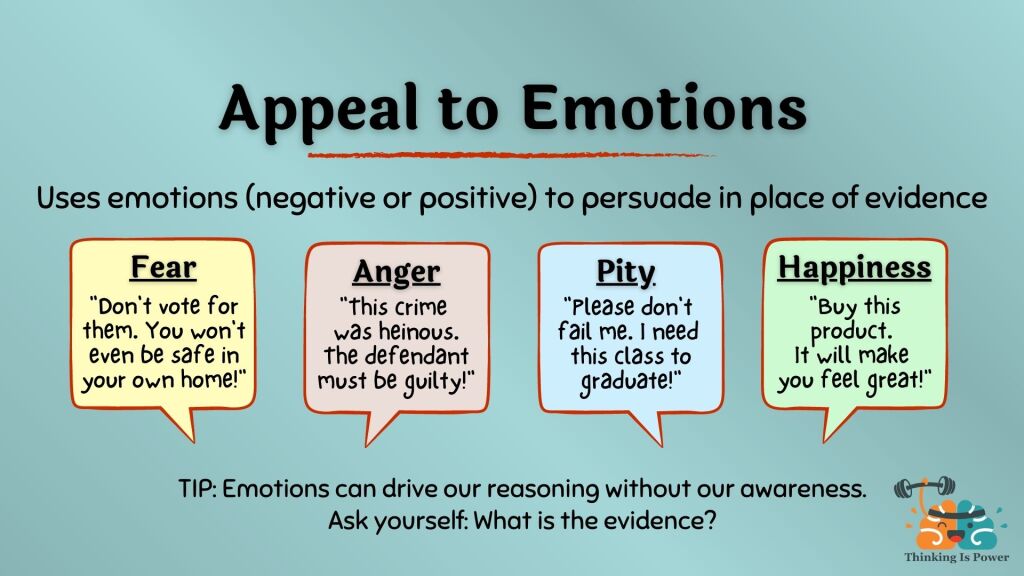
Definition and explanation: The appeal to emotion fallacy uses emotion to persuade, instead of evidence.
This fallacy is actually a broad category of fallacies that includes appeals to any number of emotions, ranging from negative –– anger, jealousy, shame, hate, and disgust — to positive — happiness, hope, courage, and love. Recognizing which specific emotion was used isn’t as important as realizing that an argument has substituted logical reasons with emotional ones.
However, it’s important to note that the use of emotions in-and-of-itself is not fallacious, as they can be relevant to an argument. It’s only fallacious when feelings are used instead of facts as evidence that something is true or false.
The appeal to emotion fallacy is often used alongside other fallacies and rhetorical techniques in an attempt to bolster up an argument. For example, loaded, hyperbolic, or even inflammatory, language is common, as are ad hominem attacks, name-calling, YELLING, etc.
As you might expect, the appeal to emotion is common in advertisements, politics, propaganda…and quite frankly, everywhere. It can also be very effective, as many of us are unaware of how much our emotions can drive our reasoning. This not only leaves us vulnerable to emotional manipulation by others, it also makes us prone to committing this fallacy ourselves. (When we’re emotional we tend to make emotional arguments.)
If you notice that you’re emotionally triggered in some way, practice emotional skepticism. Instead of allowing your emotions to control you, try to take a step back and evaluate the arguments on their merits.
How to counter: As always, it’s important not to commit this fallacy yourself. One of the most important – and difficult – critical thinking skills is emotional awareness. Ask yourself: are my emotions driving my reasoning? And if so, am I using emotions to argue? In short, try to argue with facts, not feelings.
If someone else is appealing to your emotions, consider that it might not be a deliberate attempt to manipulate your reasoning. Sometimes they’re a reflection of the emotions of the person making the argument. We all do it from time to time, so have empathy! They may not realize what they’re doing. Instead, kindly point out the error and ask for evidence.
The bottom line is that arguments should be supported by evidence – and emotions aren’t evidence.
Appeal to nature
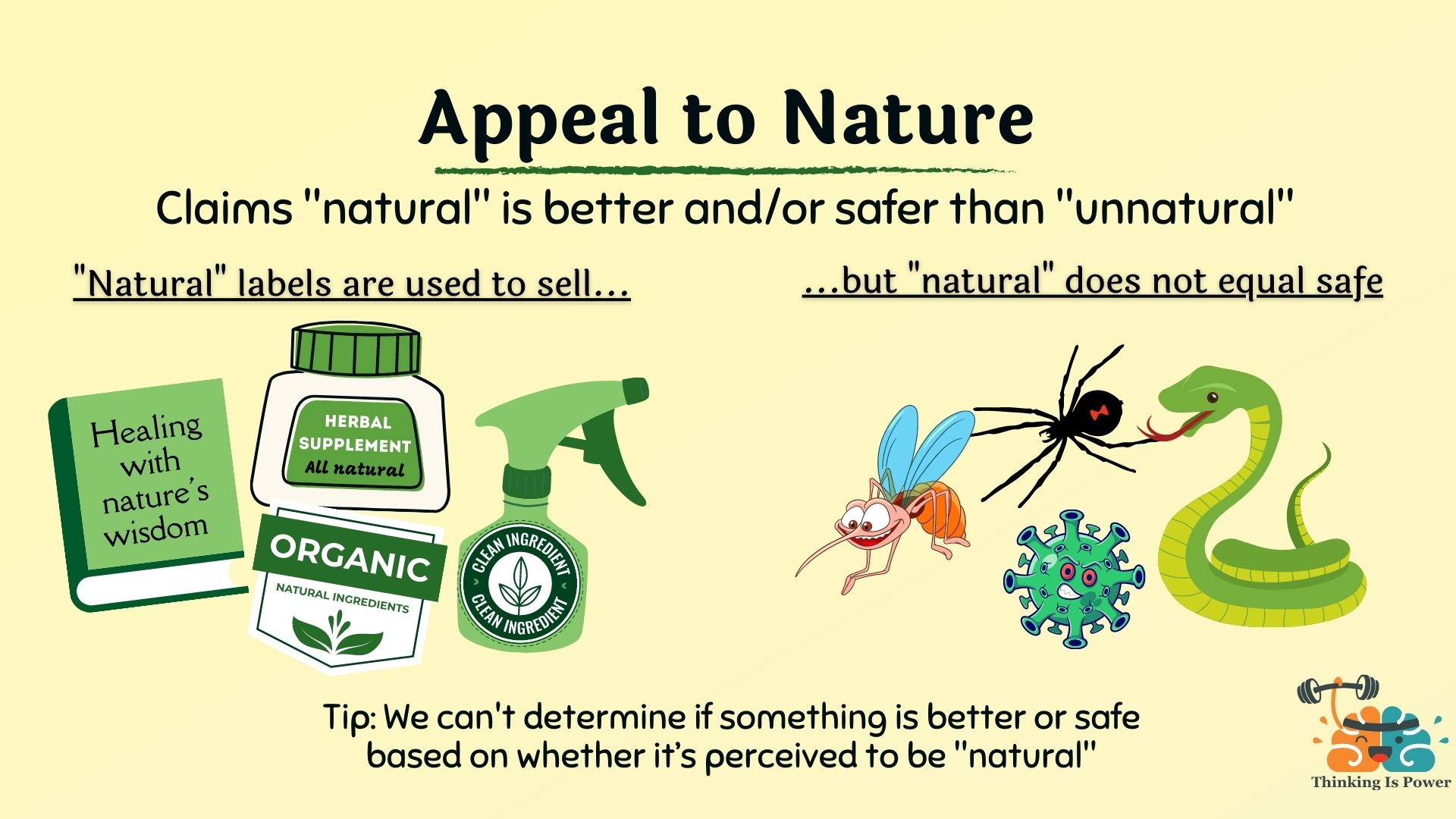
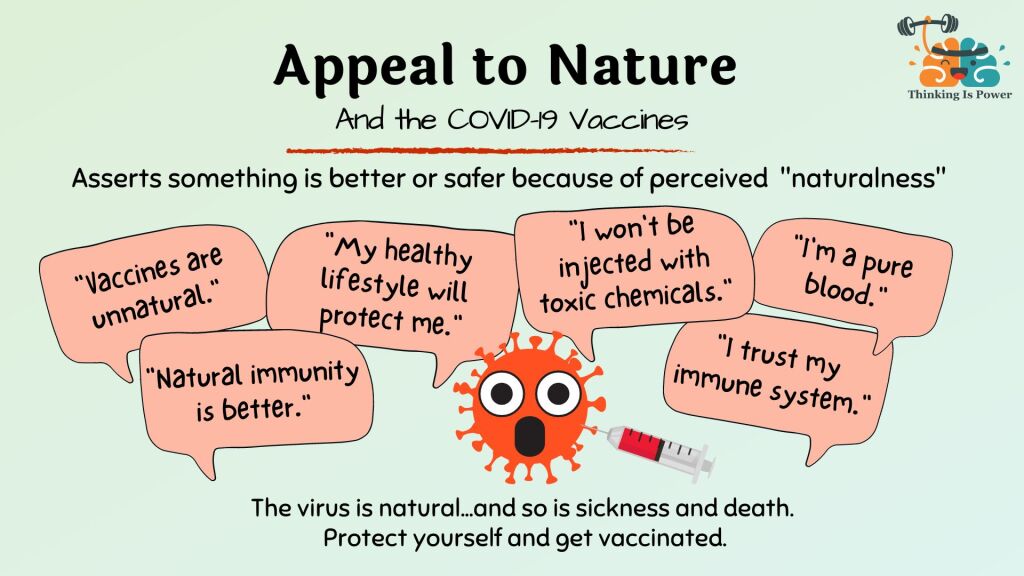
Definition and explanation: The appeal to nature fallacy argues that something is good because it’s natural or bad because it’s unnatural.
There are two major reasons the appeal to nature is fallacious:
- “Natural” is difficult to define. Many things that are “unnatural” come from nature, so when does something stop being natural? For example, oil is natural, and plastic is made from oil. Is plastic natural? Many antibiotics originally came from nature, so are antibiotics natural?
It’s also often unclear what someone means by “natural.” People will often use vague terms like “chemicals” to denote that something is unnatural. But literally everything is made of chemicals.
The point is, dividing things into natural and synthetic is often a false choice. Like most things in life, it’s not black and white, but shades of gray.
- We can’t assume something is good based on whether it’s natural or unnatural. I have bad news: nature doesn’t care if you live. Nature is full of things that will harm or kill you, from typhoons to botulinum to viruses to sharks.
Also, human advancements that are considered “unnatural” have greatly improved our quality and quantity of life. Flushing toilets, treated drinking water, antibiotics, and vaccines have nearly doubled our life expectancy over the last century.
Appeals to nature are very common, as advertisers are acutely aware of our tendency to think natural equals good. For example, “all natural” labels are ubiquitous on food packages; personal care products claim they are “plant based” and “chemical free”; and alternative medicine routinely claims its “natural” treatments are safer than the “chemicals” and “pharmaceuticals” used in modern medicine.
The point is, the appeal to nature is fallacious because we simply cannot determine if something is good based on whether it’s perceived to be natural.
How to counter: First, try not to fall for the fallacy yourself! Notice how often it’s used to sell products. Then ask yourself what they mean by “natural,” and remember that its supposed naturalness doesn’t inherently mean it’s good.
When countering the appeal to nature fallacy, keep in mind how pervasive the belief is. Consider asking questions to get to the root of someone’s misunderstandings, and based on their responses, offer gentle explanations.
To learn more: The Logic of Science: Dying the way that nature intended: Appeal to nature fallacies
Appeal to tradition
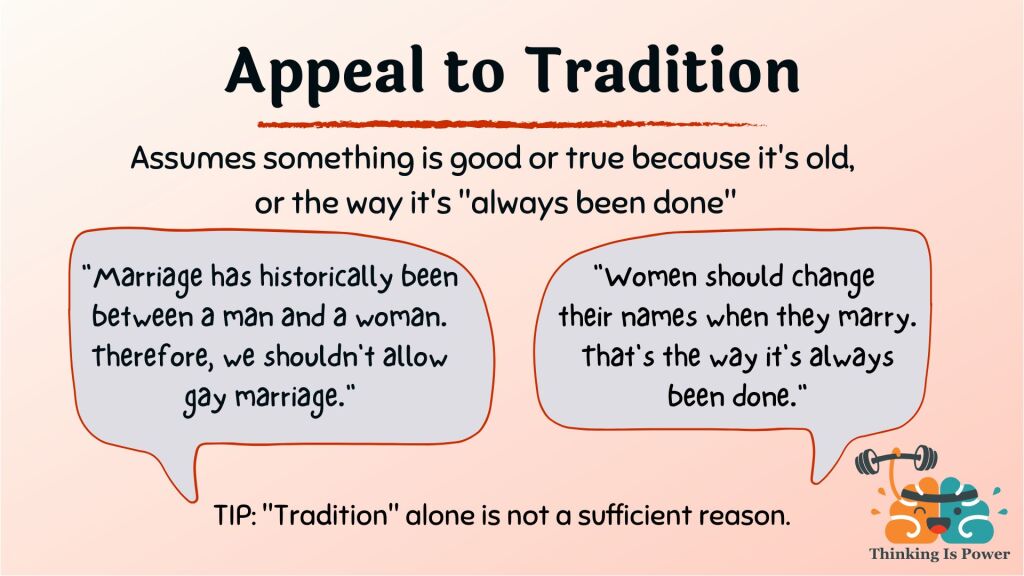
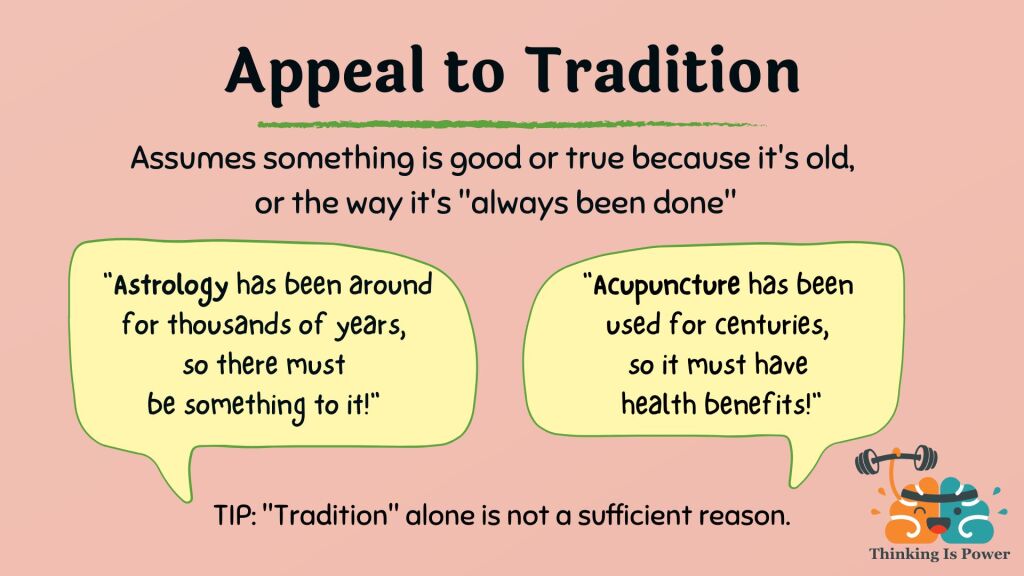
Other names: Appeal to antiquity, appeal to age, appeal to custom
Definition and explanation: The appeal to tradition fallacy asserts that something is good or true because it’s old, or because it’s the way it’s “always been done.”
People have a fascination with the past, from ancient civilizations to old cultural traditions to long-standing familial practices. We tend to stick with the familiar, and assume it’s the right, or better, way of doing things. We have believing brains, and often believe what we’re told, perpetuating beliefs over generations, even if the beliefs aren’t true.
The appeal to tradition fallacy is very common, and if you’re not paying attention it can be quite convincing. We equate being around for a long time with standing the test of time. For example, astrology has been used for millennia, and acupuncture is an ancient practice… so they must work! Sometimes that’s true. But we’ve also weeded out a lot of bad ideas. The “ancients” believed the earth was flat and diseases were caused by witches. We can thank science and progress for discovering that germs cause diseases and bloodletting isn’t an effective treatment. (Or burning witches at the stake!)
The appeal to tradition is fallacious because it substitutes actual reasons with historical ones. If something truly works, provide the evidence. “Ancient wisdom” and “this is the way it’s always been done” are NOT sufficient.
How to counter: First, try not to fall for the fallacy yourself! Notice how often it’s used to sell products and services, or to justify existing social, cultural, or religious practices. Then ask yourself: Other than tradition, what is the evidence?
When countering the appeal to tradition fallacy, remember how pervasive the belief is, then consider explaining why it’s fallacious. It might even be a good opportunity to explain the value of evidence!
Argument from ignorance
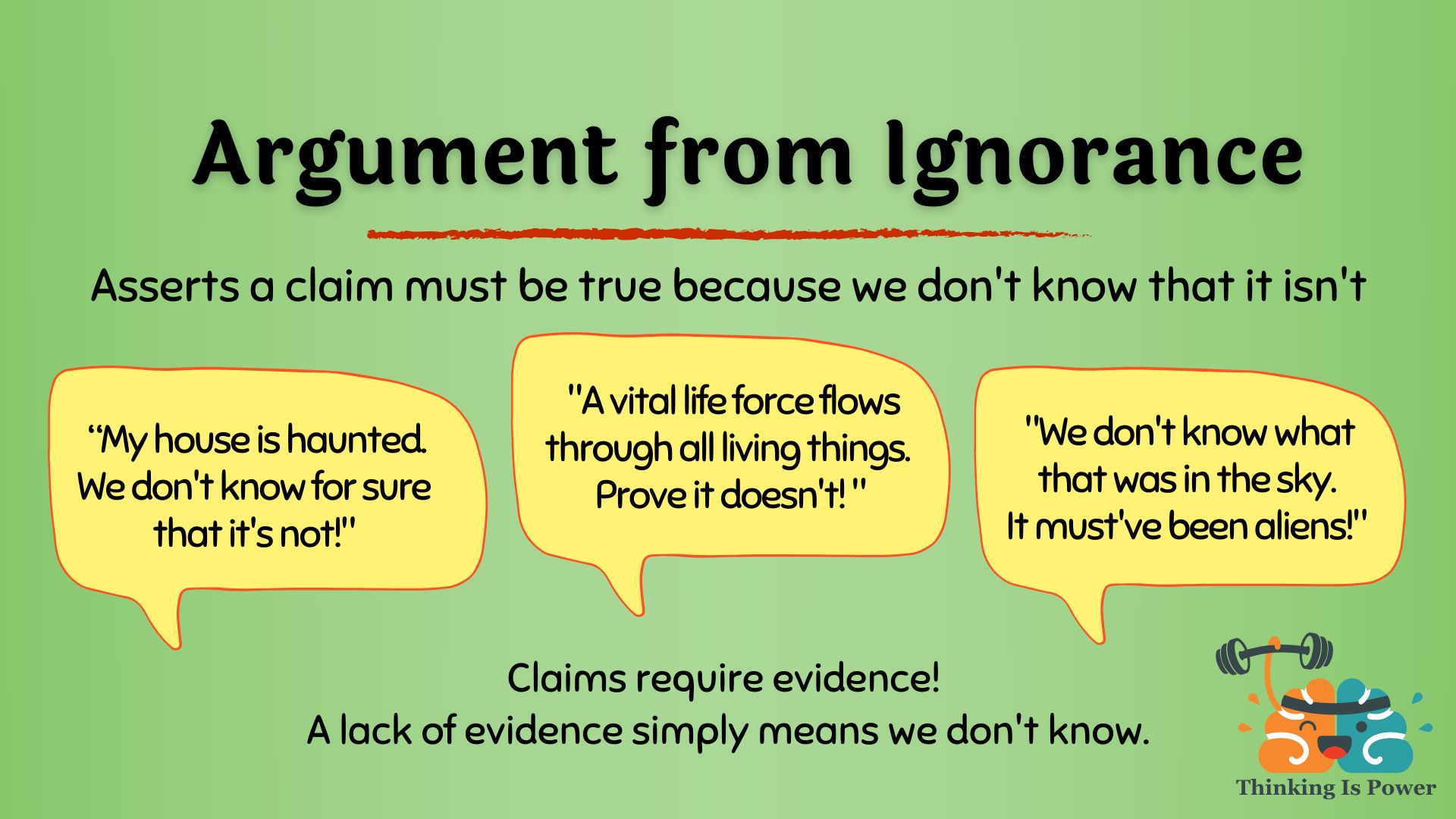
Other names: Appeal to ignorance
Definition and explanation: The argument from ignorance fallacy asserts that something is true, because we don’t know that it’s not. A foundation of critical thinking is that claims require evidence, and claims without evidence can be dismissed without evidence. A lack of evidence simply demonstrates our ignorance, and is not a reason to believe.
This fallacy is commonly used by science deniers, pseudoscience proponents, conspiracy theorists, and believers in the supernatural who point to anomalies that aren’t immediately easily explainable as “evidence” of their beliefs. Was that a UFO? Bigfoot? A ghost? A miracle? We don’t know that it wasn’t, so it must have been!
The argument from ignorance is fallacious because when we don’t know, we simply don’t know! A more rational response is to maintain a healthy level of skepticism and demand sufficient evidence before accepting a claim.
This fallacy is frequently committed alongside the burden of proof fallacy, which is when someone makes a claim without evidence then demands their opponent disprove their claim. They then claim their belief is true because you can’t disprove it.
How to counter: If someone is unfamiliar with critical thinking, they may not understand the importance of evidence. Kindly remind them that claims require evidence. And if they demand that you disprove their claim, remind them that they bear the burden of proof.
Bandwagon
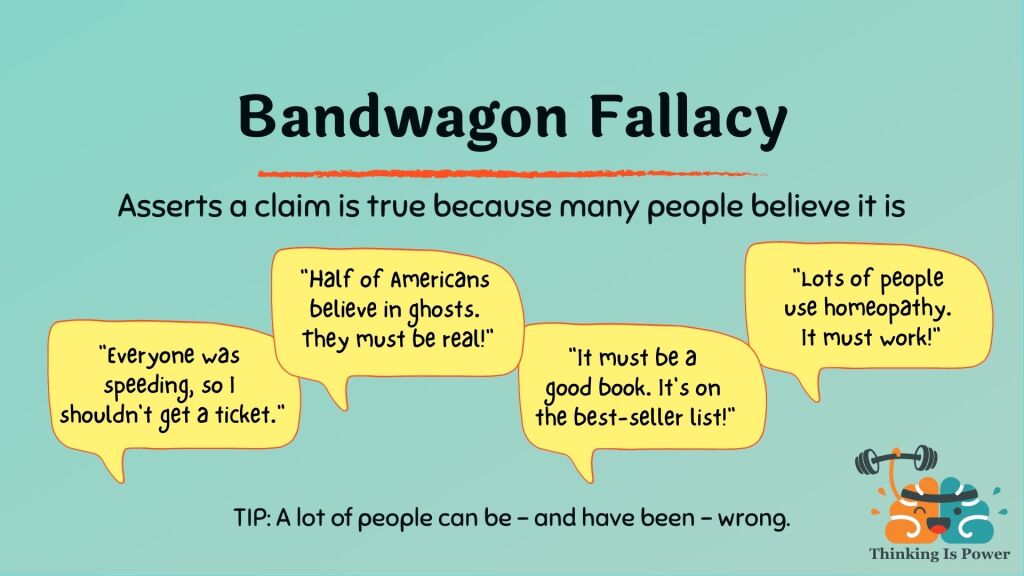
Other names: Appeal to the masses, appeal to common belief, argumentum ad populum, appeal to popularity
Definition and explanation: The bandwagon fallacy argues that a claim is true because a lot of people believe it’s true, or conversely a claim is not true because a lot of people believe it’s not.
Because humans are social animals, the bandwagon fallacy can be quite convincing. A common tactic is to claim “everybody knows” or “people say/think.” Unsurprisingly, advertisers use our desire to belong by touting the popularity of their products. Likewise, politicians appeal to their popularity when trying to earn our support. But bandwagon is fallacious because popularity doesn’t determine truth. A lot of people can be, and have been, wrong. Your parents may have warned you about the potential harm of peer pressure when they asked rhetorically, “If all of your friends jumped off a bridge, would you do it, too?!?!”
How to counter: It’s important to remember that the truth of a claim isn’t determined by its popularity but by the evidence supporting it. Therefore, once you recognize the use of the bandwagon fallacy, call it out, and ask for evidence.
Burden of proof
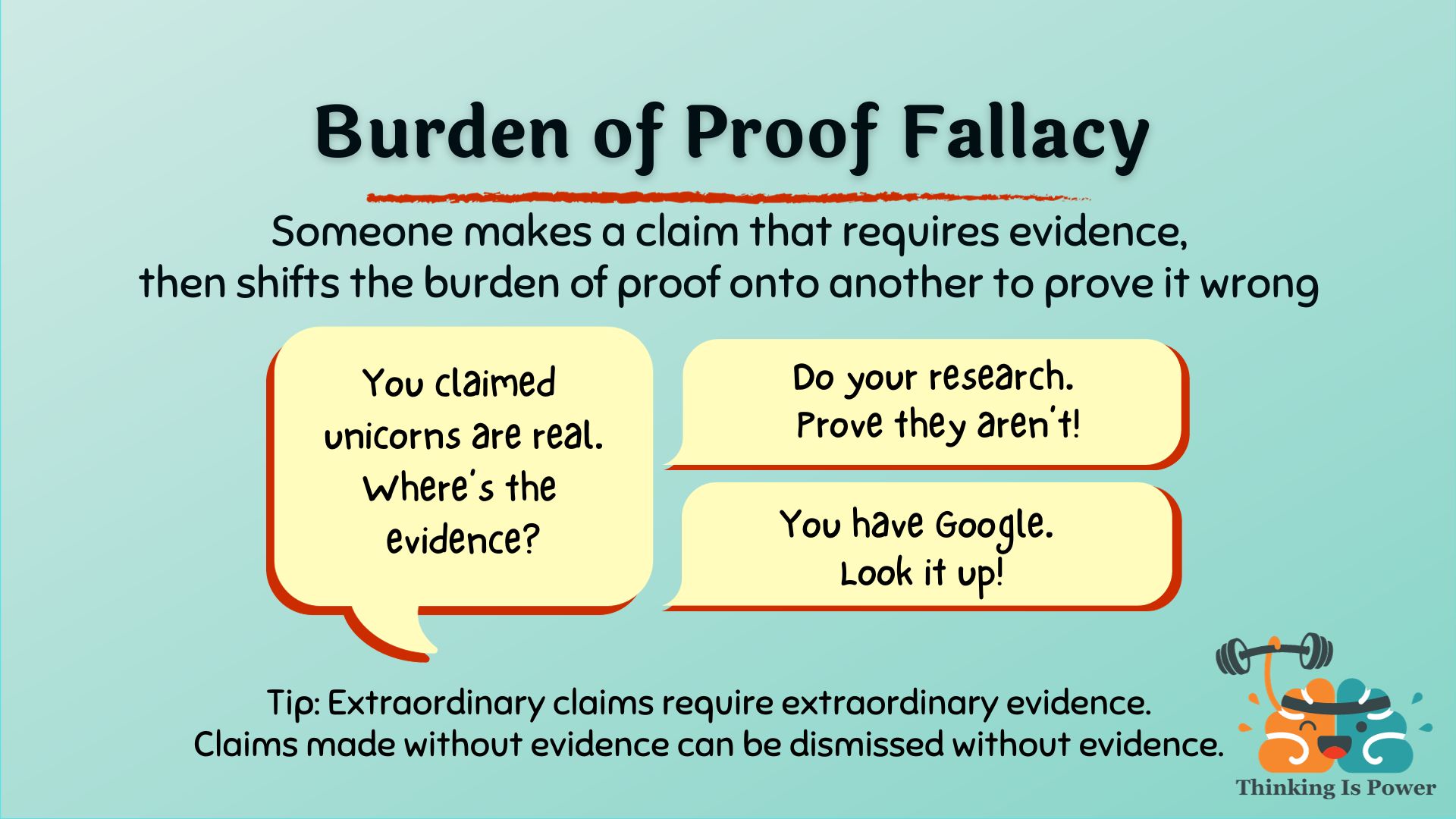
Other names: Shifting the burden of proof
Definition and explanation: A person who makes a claim bears the burden of proof to provide sufficient evidence for their claim. This standard is the foundation of our legal system, the process of science, and critical thinking. How much evidence is sufficient depends on the claim, but more extraordinary claims require more extraordinary evidence. And claims made without evidence can be dismissed without evidence.
The burden of proof fallacy occurs when someone makes a claim, but instead of providing evidence, they demand their opponent disprove their claim. To illustrate why this is fallacious, imagine a prosecutor charging a suspect with murder, but instead of presenting evidence to establish the suspect’s guilt beyond a reasonable doubt, they demand the suspect prove their innocence. The point is, it’s never up to anyone else to prove your claim wrong. You made the claim, you need to provide evidence.
The burden of proof fallacy frequently appears alongside the argument from ignorance fallacy, which is when someone asserts a claim is true because no one has proven it false. But remember that the truth of a claim is determined by the amount of evidence supporting it. A lack of evidence simply means we don’t know.
How to counter: Evasion of the burden of proof can take many forms, from shifting the burden to their opponent (eg “prove me wrong”), to making claims that can’t be disproved (eg supernatural or subjective), to shifting the burden onto vague sources (eg “they say”). People unfamiliar with critical thinking are often unaware of the burden of proof concept, or even evidence-based thinking. To respond, point out that they’ve made a claim that requires evidence and that they bear the burden of proof.
Cherry picking
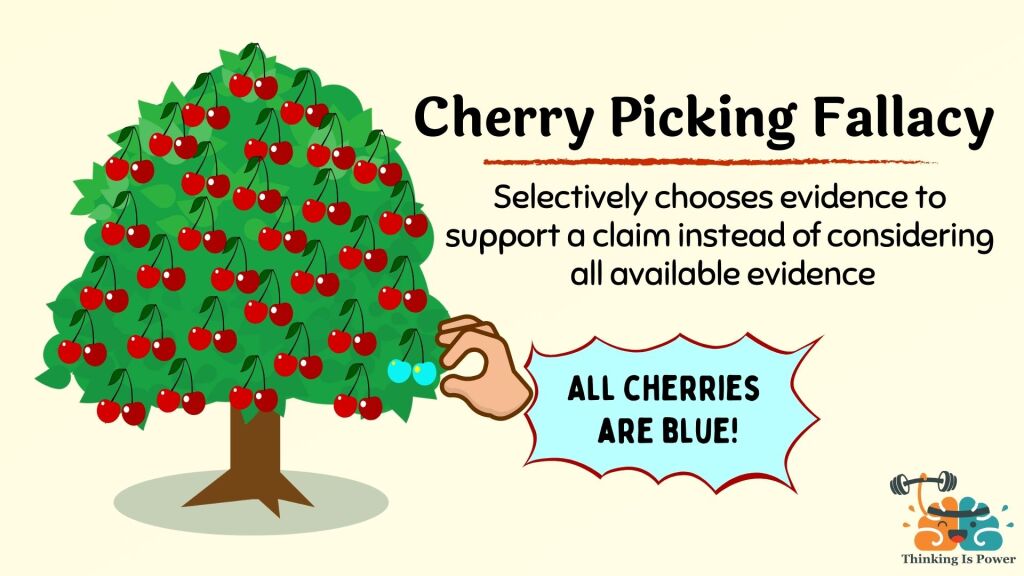
Definition and explanation: The cherry picking fallacy occurs when evidence is selectively chosen to support a claim instead of considering all available evidence.
Imagine a cherry tree, where each of the cherries represent a piece of evidence for a claim. If the goal is to determine the truth of the claim, it’s essential to look at the body of evidence. But by cherry picking favorable evidence – and ignoring contradictory evidence – the overall understanding of an issue can be distorted.
It’s possible to selectively choose evidence to support nearly any position and miss the bigger picture. For example, everything living thing needs liquid water. In fact, water is so essential to life that, when looking for life outside of Earth, we look for evidence of water. But, what if I told you that all serial killers have admitted to drinking water? Or that it’s the primary ingredient in many toxic pesticides? Or that drinking too much water can lead to death? By selectively choosing these facts, we’re left with a distorted, inaccurate view of water’s importance for life.
Sometimes cherry picking is a deliberate attempt to deceive. However, sometimes it’s not purposeful, but a result of the arguer’s desire to believe. (No one can lie to us like we can.) In either case, the more motivated we are the “better” we are at cherry picking, and the more fallacious the argument.
How to counter: This fallacy can be convincing and can even lead to overconfidence in a position. After all, cherry picked evidence is still evidence! That said, if the goal is to find the truth, all evidence must be considered.
As always, be sure you don’t commit this fallacy yourself! Be aware of potential emotions and biases that could be driving your reasoning.
And if someone else commits this fallacy, apply the principle of charity. It’s possible that their selection of evidence was caused by a desire to believe, not a desire to deceive. Then gently point out evidence they might not have considered.
False Cause
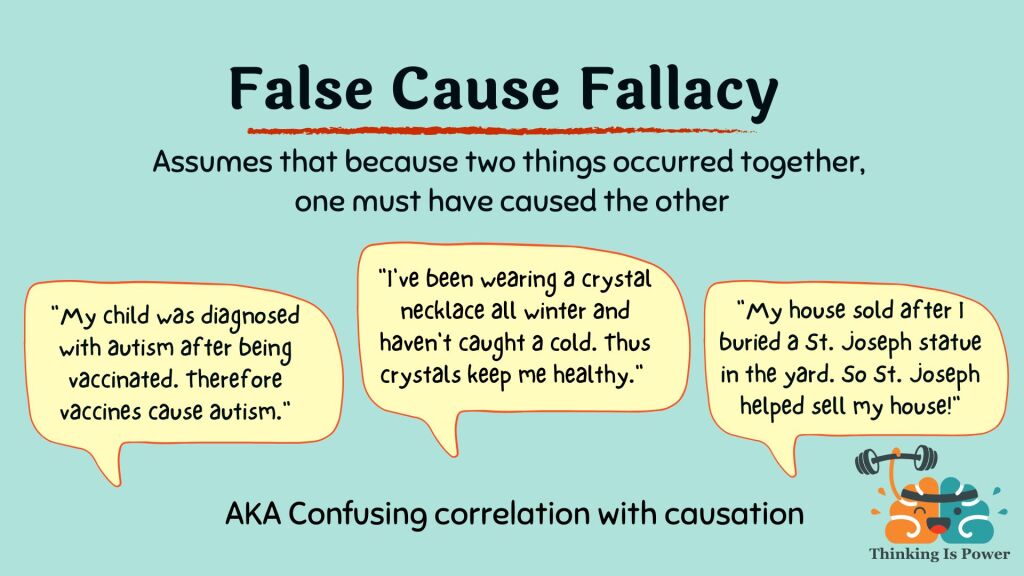
Other names: Confusing correlation and causation, Questionable cause, Mistaking correlation for causation, Post hoc ergo propter hoc
Definition and explanation: The false cause fallacy assumes that two events are causally connected when they aren’t.
You may have heard the phrase, “Correlation doesn’t prove causation.” And it’s true… but what does that mean? Let’s start with a couple of definitions:
- Correlation: A co-relationship or link exists between things or events, so that they occur together
- Causation: A change in one thing or event causes a change in another
The point is that just because two things occur together doesn’t mean one caused the other. Sometimes it’s just a coincidence, and sometimes there’s something else causing both events.
For example, every morning the rooster crows and the sun rises. These two events are correlated. But the rooster doesn’t cause the sunrise.
While that may be an obvious example, it’s very easy to confuse correlation and causation. And if we’re not careful, we can easily be fooled. It’s human nature to search for explanations by finding patterns and connecting the dots. Maybe you ate a sandwich for lunch and threw up later? Or maybe you wore your lucky socks and hit a home run? But are these events causally related? We often don’t know, yet assume we do.
Science can help sort correlation from causation, but it’s complicated, as only carefully controlled studies can demonstrate causation. Let’s say we want to find out if Echinacea treats the common cold. We randomly divide subjects into two groups, where one gets Echinacea and the other a placebo. (Importantly, we don’t let the participants know which group they’re in!) If the group receiving Echinacea reports shorter and less severe colds than the placebo group, we can say that Echinacea has a causal effect on colds. This research has been done, and Echinacea does not treat colds. However, many people will swear that it does, because they’ve tried it and their cold went away. Some of this is probably a placebo effect. But also… colds go away. That’s a correlation.
However, it’s not always possible (or ethical) to control. Therefore much of science involves observational studies, where data is collected in the “real world.” Because the real world is messy, these studies only provide correlations. For example, people observed that smokers tended to get lung cancer. We can’t ethically ask study participants to smoke to see if they get sick… so we had to study the issue in other ways, such as epidemiological studies. Through lots of research exploring the different possible variables that could be causing the link between smoking and lung cancer, eventually we concluded smoking almost certainly causes lung cancer.
The false cause fallacy is extremely common, so it’s important to learn how to recognize it so we don’t fall for it ourselves. We not only see patterns everywhere, much of science is based on studies that provide “links.” We should always keep in mind the limits of what we can say about the relationship between events. Your best bet is to be skeptical and hold off on assuming causation until you know more.
How to counter: First, try not to fall for the fallacy yourself! Notice how often you perceive correlations. Then think through what else might be behind the relationship. We all want explanations, and understanding the difference between correlation and causation can be an empowering way to make better decisions.
In conversations with others, remember that they may not know the difference between correlation and causation. So if someone commits this fallacy give them the benefit of the doubt, and try to gently explain it to them. We all would benefit from understanding the difference!
False choice
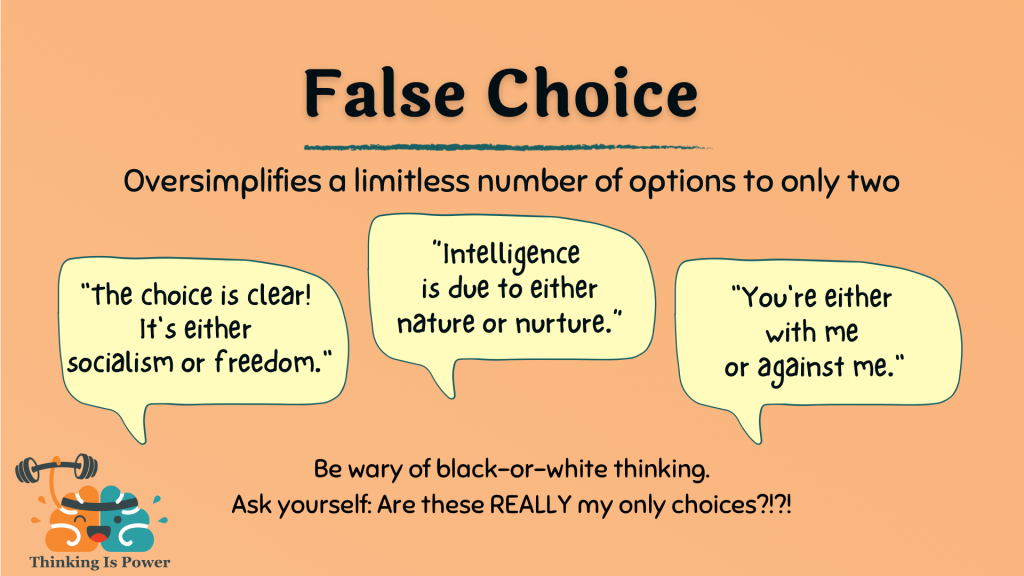
Other names: False dilemma, false dichotomy, black-or-white, either/or, fallacy of the excluded middle
Definition and explanation: The false choice oversimplifies a complex issue into two options, ignoring the possibility that other options may exist. In this fallacy, the arguer frames their opponent’s choices as black or white, this or that, when in reality there is likely a spectrum of options in between. Often, the choices presented are used to shut down debate and force an opponent into the arguer’s preferred position.
False choice fallacies are quite common, and they can be very powerful, so it’s important to be able to recognize them. Binary thinking can force us into positions we wouldn’t normally take. The false choice is fallacious because the vast majority of the time there are more than two positions available to us.
How to counter: First, consider the possibility that the false choice was unintentional, due to an emotional attachment to one of the choices or a lack of knowledge on the issue. Sometimes, however, the false choice was a purposeful attempt to strengthen the arguer’s position, by presenting their view as the only reasonable option. Depending on the circumstances, it can be difficult to propose an alternative, as the two options may have been presented to force choosing a side.
The most important thing is to not let a false choice limit your options. So ask yourself, are these really my only two choices?
False EQUIVALENCE
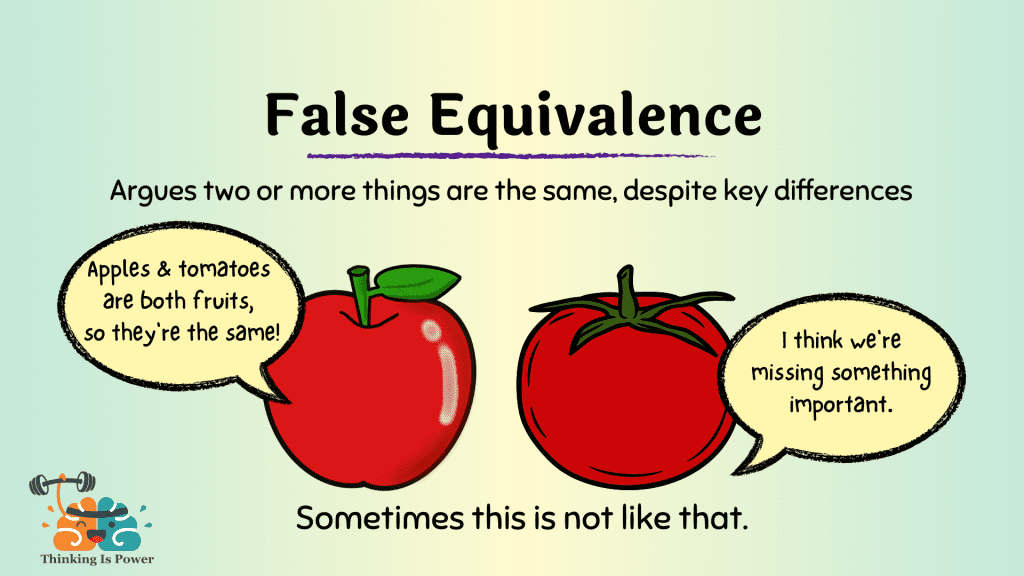

Definition and explanation: The false equivalence fallacy argues that two or more things are the same, despite having important differences.
Comparisons can be a powerful way to understand new concepts, as they help us to make connections with things we already know.
But the devil is in the details. While superficial similarities are often easier to see, they may be masking important differences…and if we’re not careful we could be misled.
The false equivalence fallacy can take many different forms, some of which include:
- Oversimplifying a comparison by exaggerating a shared characteristic, downplaying important differences, or removing essential context or nuance, such as comparing things that have differing orders of magnitude. Or in other words, comparing apples to oranges.
- Presenting a false balance by giving equal weight to “both sides” of an argument despite one side being supported by significantly more evidence. Sometimes called bothsidesism, this type of false equivalence is often committed by the media, especially when covering science. In their attempt to avoid bias, opposing “sides” of an issue are given equal air time, creating the impression of a balanced debate.
- Drawing a moral equivalence between actions that aren’t comparable. Commonly used alongside the moral equivalence is the rhetorical tactic known as whataboutism (i.e., “yeah, but what about”), which brings up another issue to deflect criticism.
False equivalences are very common and can be quite persuasive if you’re not paying attention. It’s often easier to see similarities than it is to dive into the weeds and analyze how things are different, but just because they seem to share an attribute does not make them equivalent. So if someone makes a comparison, stop and ask yourself: Are there important differences that would invalidate the conclusion?
How to counter: First, it’s important to not commit this fallacy yourself! If you’re making a comparison, don’t just think about how they’re similar, try to think about how they’re different. Make sure you’re able to justify why things are equivalent in a way that’s relevant to the conclusion.
In conversations with others, (kindly) explain to them why their argument is flawed. Point out that, while there are similarities, there are key differences that impact their conclusion.
GALILEO GAMBIT
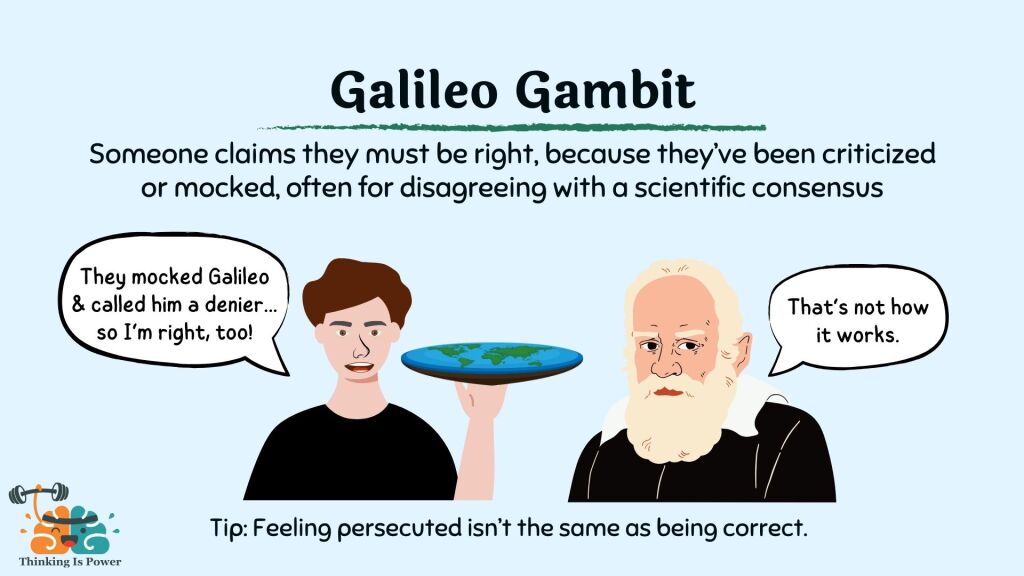
Definition and explanation: The Galileo gambit claims that someone must be correct because they’ve been criticized, often for disagreeing with a scientific consensus. The argument suggests that, since Galileo was thought to be wrong but was later proven right, people who are thought to be wrong today will also be proven right.
Galileo Galilei (1564-1642) was an astronomer who was convicted by the church for his support of heliocentrism, the idea that the sun (and not the earth) was the center of the universe.
Those who deny science are quite fond of pointing out that “Galileo was branded a denier” and often point to this famous quote: “In questions of science, the authority of a thousand is not worth the humble reasoning of a single individual.”
But many who use Galileo’s name are missing a few important things.
The Galileo gambit is a type of false equivalence, which compares things that have important differences. For example, Galileo was suppressed by the Church, not the “scientific establishment”. While the scientists continued to disagree and collect evidence, they didn’t ban his teachings or put him under house arrest for heresy. Conversely, the Church didn’t clear Galileo’s name or admit he was right until 1992!
And importantly, disagreeing with a consensus doesn’t make a position correct. The vast majority of people (scientists included!) who refuse to accept well-supported scientific conclusions are just wrong.
Those who compare themselves to Galileo imagine themselves as being persecuted or censored for bravely standing up to a scientific establishment. But feeling persecuted isn’t the same as being correct. And ironically, those who deny overwhelming evidence bear more resemblance to the ideologically-motivated church than to the scientific community.
This fallacy is also based on the idea, largely a myth, that scientific advancements are overturned by lone geniuses. Heliocentrism predated Galileo by over a thousand years, and was a mainstream position amongst astronomers decades before Galileo’s letter to the church. Galileo was building on the work of other scientists, such as Nicolas Copernicus, and around the same time, Johannes Kepler was developing the laws of planetary motion. The point is that, Galileo was not working in isolation and his ideas did not overturn the consensus theories amongst astronomers of the time.
For every fringe idea that turns out to be true, there are countless others that are just wrong. As Carl Sagan said, “The fact that some geniuses were laughed at does not imply that all who are laughed at are geniuses. They laughed at Columbus, they laughed at Fulton, they laughed at the Wright brothers. But they also laughed at Bozo the Clown.”
Circling back to Galileo’s quote, the “authority” of which he was speaking was the religious authorities in the Church, not scientists. He also wasn’t saying that disagreeing with authorities is what makes someone right, but their “humble reasoning.” In short, evidence trumps authority.
The point is, denying a consensus doesn’t make you like Galileo. Revolutionary ideas do get accepted, but they require evidence. We don’t remember Galileo because he disagreed, but because he was right.
How to counter: While science denial relies heavily on the use of logical fallacies, the Galileo gambit is one of the most reliable indicators. It’s easier to think of ourselves as outsider geniuses heroically standing up for the truth than it is to admit the much more likely possibility that it’s us who’s wrong. No one likes to think of themselves as a science denier.
Science denial usually stems from a desire to avoid accepting conclusions that conflict with our identity or ideology, or those in which we don’t like the solutions (i.e., solution aversion). Thus, if you see this fallacy in use, consider the underlying motivations.
One option is to explain why the comparison with Galileo doesn’t stand up to scrutiny.
Or you could simply ask, what evidence would change their mind?
Hasty GeNeralizationS
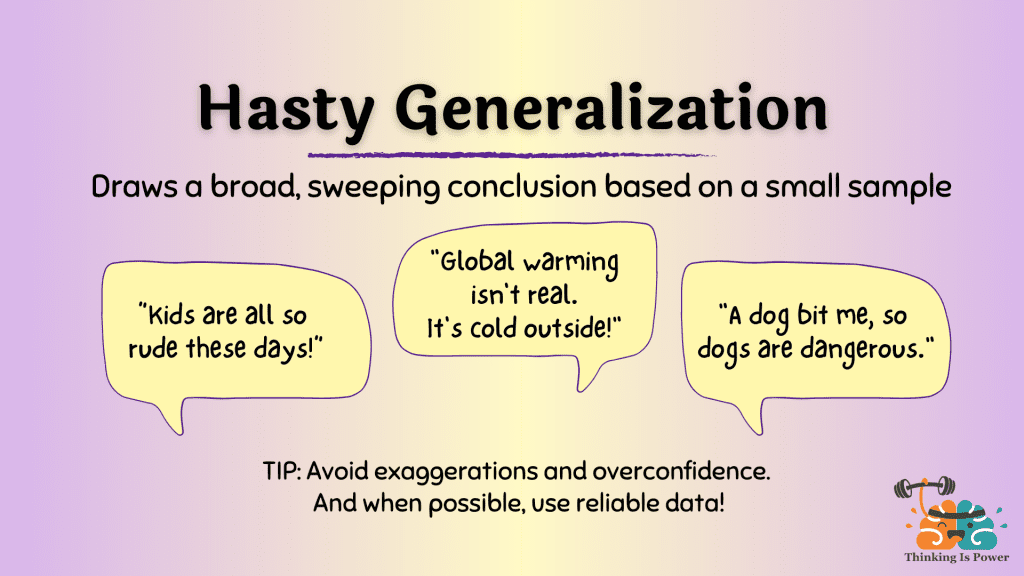
Other names: Jumping to conclusions, argument from small numbers, overgeneralization, biased generalization
Definition and explanation: The hasty generalization fallacy draws a broad conclusion based on a small sample.
All day, every day, we use limited information to generalize. By definition we have to, as we will never have fully complete data sets to analyze for each and every decision. However, the strength of our conclusion depends on our sample: those based on larger and more representative samples are significantly stronger than those based on smaller or atypical samples.
The hasty generalization fallacy occurs when we use limited evidence (i.e. a small sample) to make a broad claim. Often the examples we use to support our conclusion (i.e. our “sample”) are simply anecdotes, such as our own personal experiences or stories we’ve heard from others. Armed with our “evidence”, we jump to a conclusion. Essentially, we assume our “sample” is representative of reality. But not only are our experiences limited, our biases can influence the examples we choose, resulting in a conclusion that isn’t justified.
For example:
- Anthony was bitten by a cat when he was young, so he concludes that “all cats bite.”
- Leslie claims “smoking isn’t bad for you,” because his dad smoked his whole life “and was fine.”
- Monica was mugged on her vacation in Sydney, so she claims that “Australia is a dangerous country.”
- Jason doesn’t like the news coverage of his favorite politician, so he says “all media is biased.”
Hasty generalizations can lead to the formation of stereotypes, as we assume our limited experiences with people can be generalized to their supposed “group.” For example:
- Mauve hasn’t had the best experience with her younger co-workers, so she claims that “all Millennials are lazy.”
- Sean was cut off in traffic by a female, so he thinks that “all women are bad drivers.”
- Marjorie saw a news story about an illegal immigrant who committed murder, so she says that “all illegal immigrants are dangerous.”
- Jaimie thinks that “all Muslims are terrorists” because of the way she sees them portrayed on TV.
Hasty generalization fallacies are very common and can be quite convincing. They are supported by “evidence,” after all. (Though they’re often unreliable, anecdotes can be very powerful.) Even more, once we’ve jumped to a conclusion, confirmation bias kicks in and we “see” supporting evidence everywhere…so we become even more convinced we’re right.
How to counter: First, it’s important not to fall for this fallacy yourself. While making generalizations is unavoidable, we should remember that the resulting conclusions are tentative, and therefore avoid overconfidence and exaggerated language (e.g. all/none, always/never). In short, don’t make arguments you can’t support!
If someone else makes a hasty generalization, ask for evidence! (As always, the burden of proof is on the person making the claim.) Based on their response, consider pointing out the fallacy in their argument and that there’s insufficient evidence to justify their claim. Remember to be kind, as they honestly might not know their argument was flawed.
Either way, consider looking up reliable data (if it’s available), and proportion your acceptance of the conclusion accordingly.
I’m entitled to my opinion
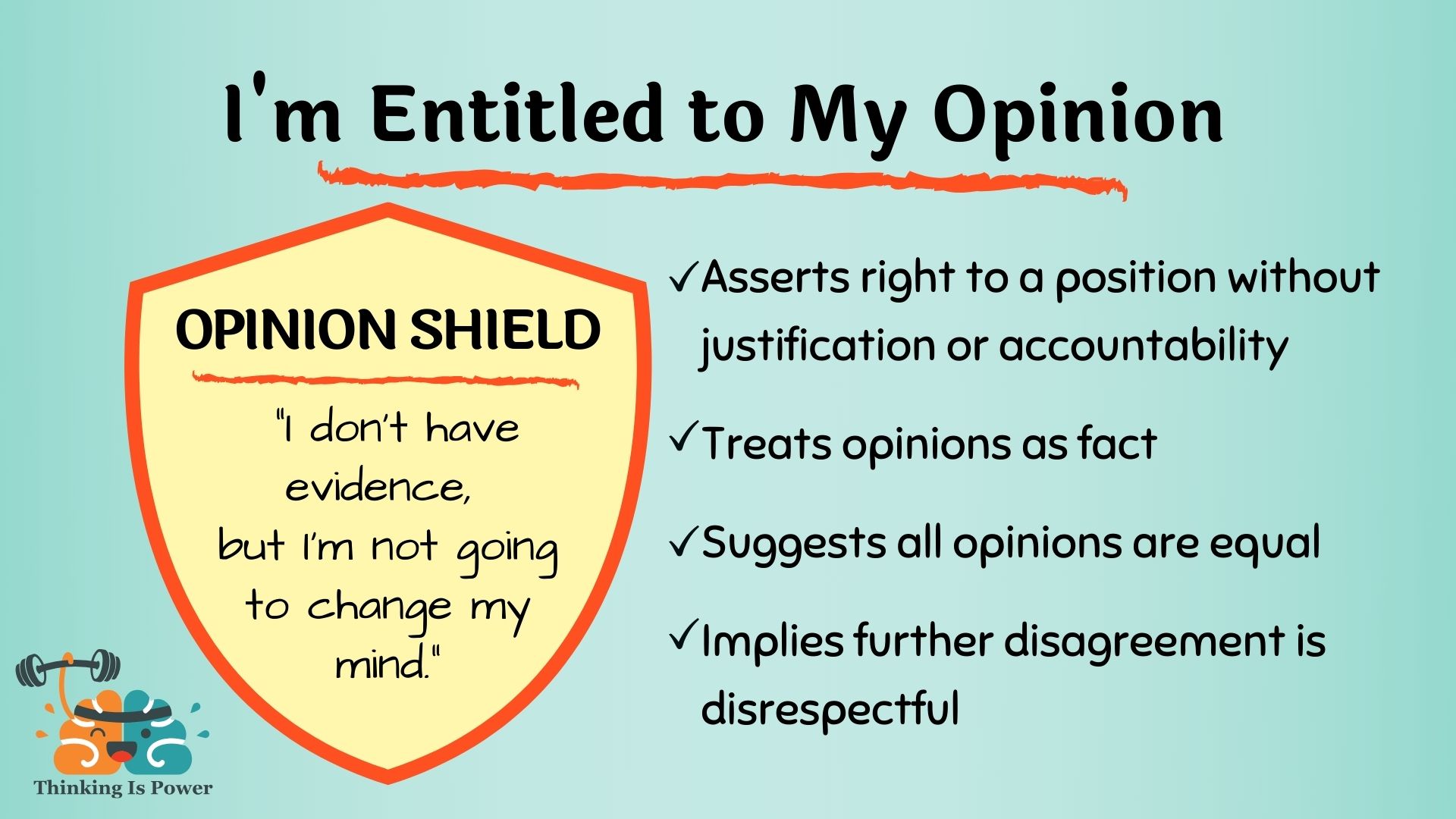
Definition and explanation: It is true that everyone is entitled to their opinion. However, “I’m entitled to my opinion,” is often used to shield an unsupported position. And being entitled to your opinion doesn’t mean you’re right, or that anyone needs to take your opinion seriously.
There are several problems with this fallacy.
- An opinion doesn’t mean what they think it means. Opinions are subjective judgements or viewpoints. When someone claims they are “entitled to their opinion,” it’s often because they are trying to shield factually incorrect assertions.
- All opinions aren’t equal. Expert opinions are interpretations of evidence based on years of study and experience, and are significantly more robust and reliable than non-expert opinions. “I’m entitled to my opinion” suggests that their opinion is just as good as anyone else’s.
- We should all be open to changing our minds if the evidence suggests we should. “I’m entitled to my opinion” is essentially an admission that they can’t justify their position… but yet they’re unwilling to entertain contradictory evidence or other points of view.
In the face of facts that contradict a belief, especially one central to our identity or values, we use motivated reasoning to reduce the cognitive dissonance that arises when reality and our beliefs are in conflict. When that fails, our Get Out of Jail Free Card is to defend the belief by rendering it unfalsifiable and therefore immune to evidence. We move the goalposts. Discount sources or deny evidence. Proclaim that it’s our opinion.
It’s important to remember that the purpose of arguing isn’t to be right, it’s to get it right. “I’m entitled to my opinion” shuts down any further disagreement. We simply don’t want to be wrong.
How to counter: I tell my students on the first day of class that they are not entitled to their opinions. (At least not in class!) They are only entitled to what they can support with evidence.
It’s a bit trickier in the “real world.” Remember that people are often unfamiliar with the basics of critical thinking, so they may not be used to having to support their positions with evidence. Consider explaining why “I’m entitled to my opinion” is fallacious, and the benefits of healthy disagreement. The best approach is probably to ask them why they hold this particular opinion, and why they think they’re “entitled” to it.
To learn more: The Conversation: No, you’re not entitled to your opinion
PERFECT SOLUTION
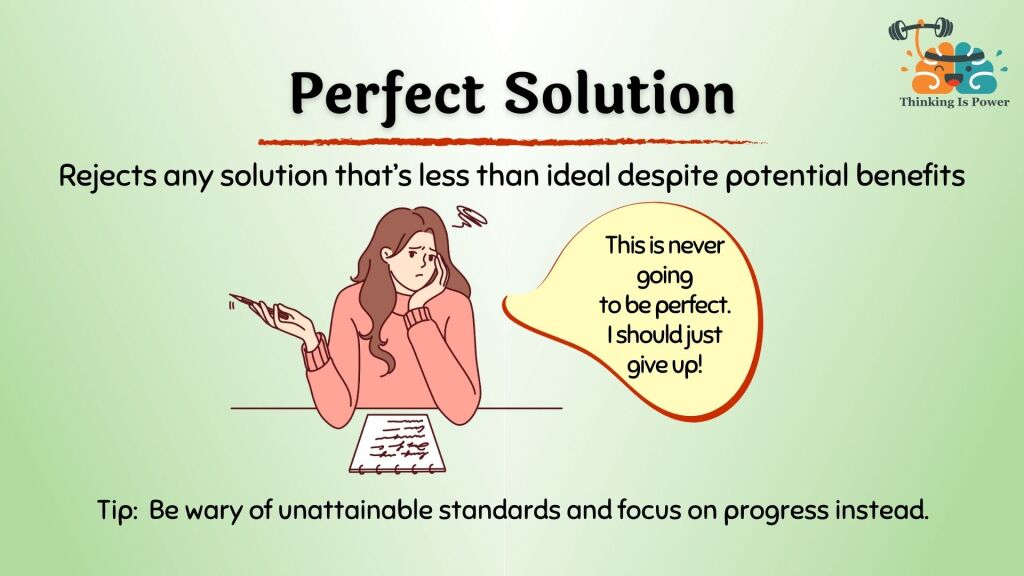
Written by Bryan Montford; edited by Melanie Trecek-King
Definition and explanation: The Perfect Solution Fallacy assumes a perfect solution exists, and rejects any solution that’s less than ideal despite potential benefits. This fallacy relies on black-and-white thinking, oversimplifying complex situations and creating a false choice between perfection and inaction. However, it’s fallacious because solutions don’t need to be perfect to provide benefits. Not only that, perfect solutions are unrealistic, unattainable, and often unnecessary.
The perfect solution fallacy can pop up in many forms in our daily lives. For example, someone might say they don’t want a relationship unless it’s completely conflict-free. Or, they won’t take music lessons because they’ll never be as good as a professional musician. Rejecting solutions because of unrealistic expectations creates inaction and missed opportunities, and dismisses the benefits of incremental improvements.
How to counter: Inaction won’t result in change or help you achieve your goals, so focus on progress instead. Be wary of arguments that hinge on unattainable standards, as solutions don’t need to be perfect to provide benefits. We can achieve progress even if solutions aren’t perfect.
Red Herring
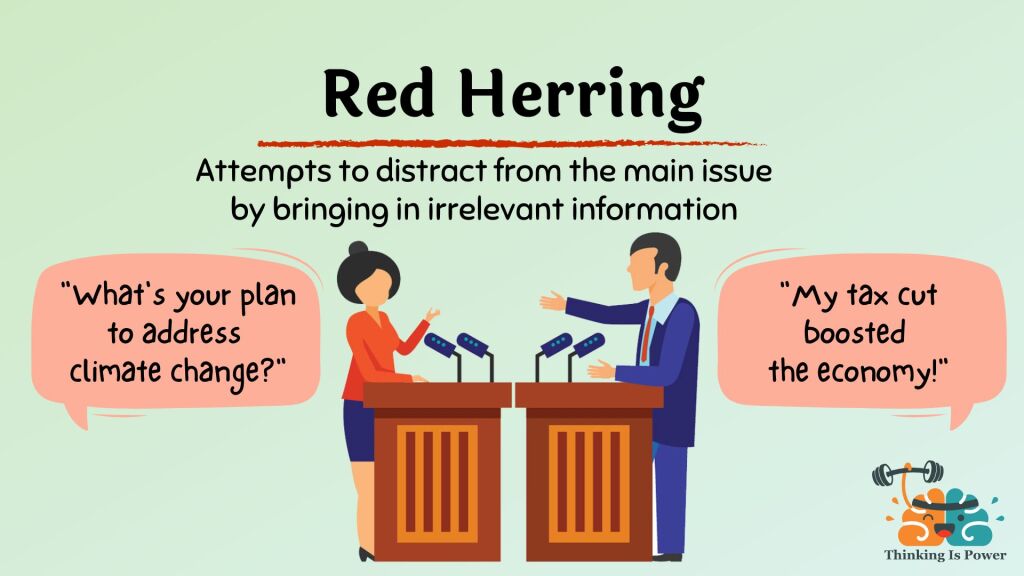

Definition and explanation: The red herring fallacy is an attempt to distract from the main issue by bringing in irrelevant information.
The name of this fallacy comes from a story in which the smelly fish were used to cover up the scent of hares to distract hunting hounds. While the story may or may not be true, it can be a helpful way to visualize how this fallacy works.
In argumentation, the red herring fallacy is used to divert attention from the main point by changing the subject. It can be difficult to recognize, as the new information might seem tangentially relevant…but in fact it’s a shift towards something that’s easier or safer for the party committing the fallacy. Basically, they lack a good response, so they confuse and distract.
How to counter: The red herring fallacy is very common, so it’s important to be able to recognize it. Pay close attention to responses to monitor if the information that’s offered is relevant to the original issue. This can be more challenging than it seems, and if you’re not careful you could end up miles away from where you intended.
If you spot a red herring, you could try to redirect the conversation back to the topic at hand. If they continue to offer distractions, gently point out the red herring and why it’s fallacious, keeping in mind that they might not be aware of their misdirections. Finally, there might be a reason the other person wishes to avoid the topic, so you could choose to move on. There might not be a point in continuing with that particular thread or even the conversation in general.
Single cause
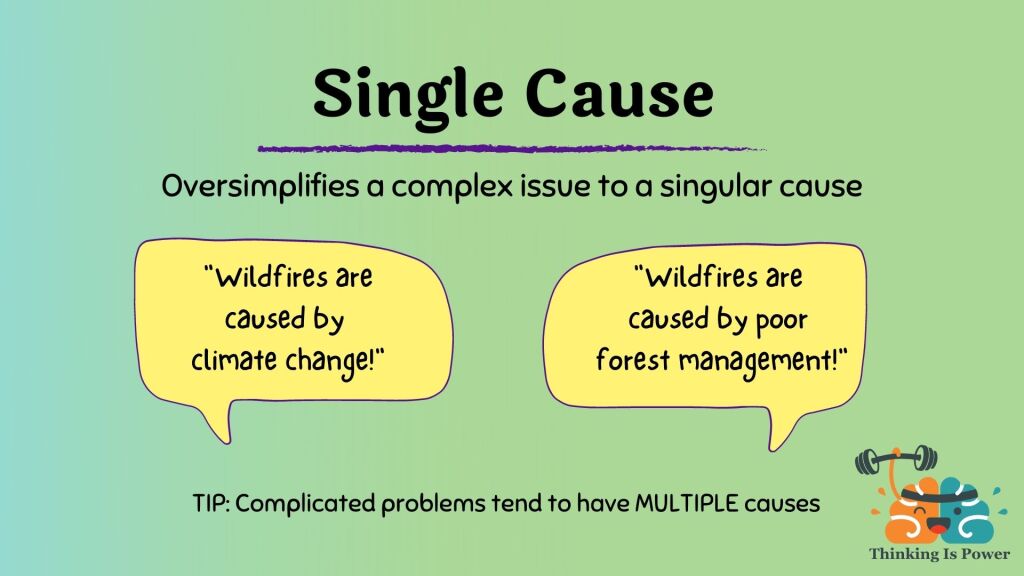
Other names: Causal reductionism, complex cause
Definition and explanation: The single cause fallacy oversimplifies a complex and nuanced issue into one simple cause. It’s human nature to prefer simple answers to complex ones. But oversimplification can lead us astray. If we are to have any chance at solving problems, we need to fully understand them.
The single cause fallacy can take many forms, from assigning blame for a problem or giving credit for a solution. However, it is fallacious because it’s likely that many factors contributed to an outcome.
How to counter: Phrases like, “The reason x happened,” or “The cause of x is,” are indicators that a single cause fallacy has been committed. However, it’s possible that the single cause fallacy was unintentional, and maybe the other person doesn’t understand the complex nature of the issue. So ask yourself, could there be more to the issue than what is being presented?
SLippery Slope
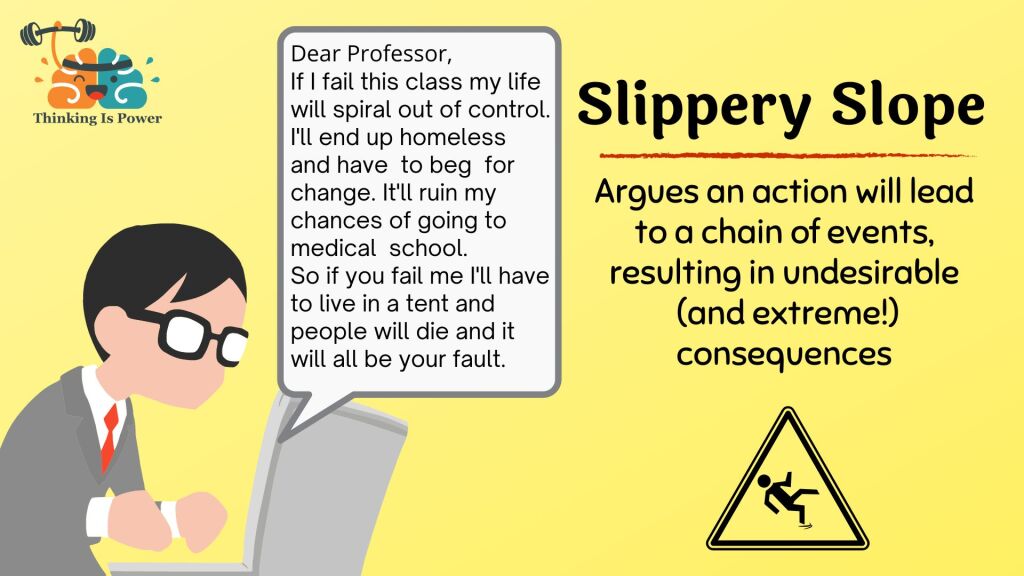
Definition and explanation: The slippery slope fallacy argues that an action will lead to a chain of events, resulting in undesirable and often extreme consequences.
Slippery slope arguments are often used to argue against an issue at hand by diverting attention towards negative and unlikely outcomes. In addition, by presenting the horrible sequence of events as inevitable, the arguer uses appeals to fear or anger to persuade (or manipulate, if it’s done intentionally) without evidence. However, the slippery slope is fallacious because moderate positions don’t necessarily lead to extreme outcomes.
Slippery slope arguments are common in political discourse. They can be quite persuasive, as when our emotions are activated we’re less able to think critically. The good news is that slippery slope arguments are easy to identify and avoid once you learn how they work.
How to counter: Critical thinking can keep us from going down a slippery slope. To identify a slippery slope fallacy, ask yourself how likely it is that the action at hand will lead to the outcome(s) presented. (Keeping tabs on your emotions is also a useful strategy.)
Once identified, consider pointing out the fallacy to your opponent, and ask them to justify their conclusion by providing evidence. The burden of proof is on the person making the claim, after all.
Straw man
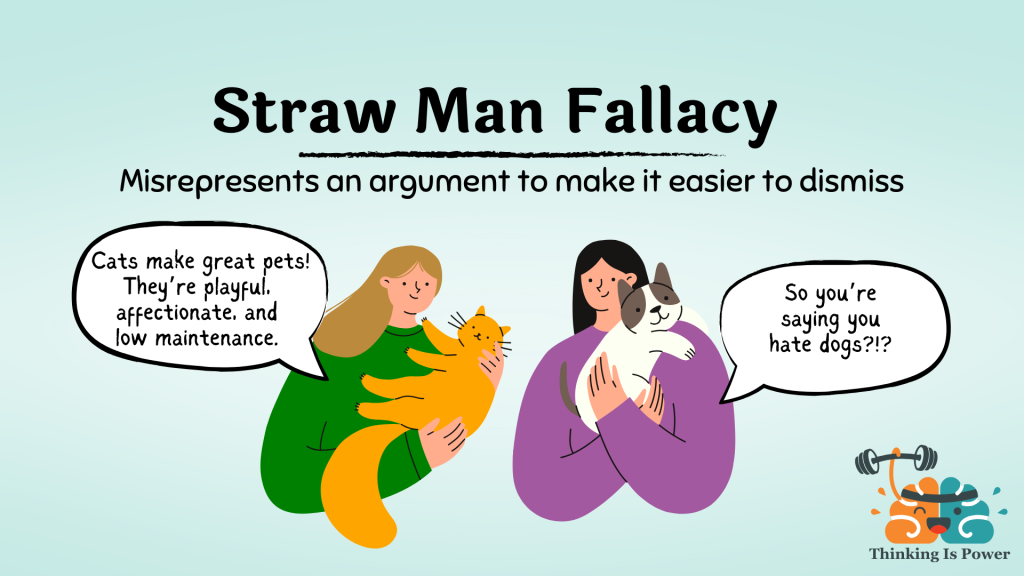
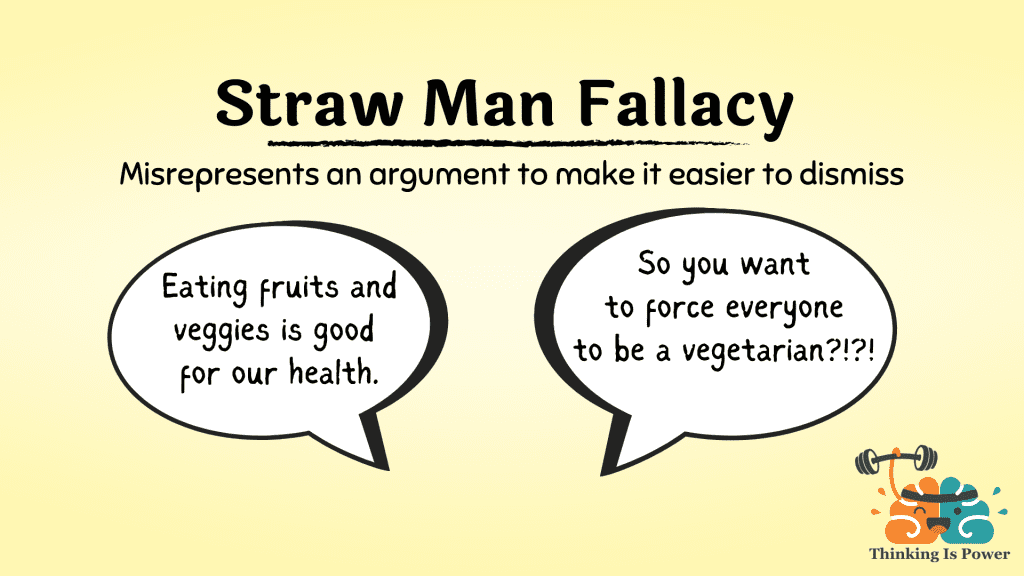
Definition and explanation: A straw man argument misrepresents an opponent’s argument to make it easier to dismiss. The straw man can take many forms, but it often involves distorting, exaggerating, oversimplifying, or taking parts out of context, and can be quite effective if you’re not paying attention. By building a straw version of the original argument they can more easily knock it down and claim victory. However, it is fallacious because they are attacking a position their opponent doesn’t hold.
Anti-science arguments often employ straw man fallacies, as it’s much easier to “defeat” strongly supported scientific conclusions when those conclusions are misrepresented.
How to counter: First, consider the possibility that the straw man argument was unintentional, and that the other person doesn’t understand the original argument. Sometimes, however, the straw man is a purposeful attempt to persuade others through deception. Either way, point out the use of the straw man by explaining how their version differs from your original position.
Resources to Learn More
Logically Fallacious
Your Logical Fallacy Is
Effectiviology: Logical Fallacies: What they are and how to counter them
Campus Explorer: 20 Types of Logical Fallacies and Examples
I love ththis kind of analytical explanations and I’m looking forward to more.
Thanks for the compliment, and you’re welcome!
Simplified and very useful article.
Thanks for the kind words. That’s exactly what I was going for. 🙂
Melanie
Thank you…
I think it would be good to list potential exceptions to these fallacies. Here are a few examples:
Slippery slope – I think there are plenty of occasions where people are quite right to be concerned about one thing leading to another, and there have been examples of it, such as dictators rising to power
Anecdotal – if you’re simply trying to prove that something exists or is possible, rather than common or likely, then your own experience is sufficient proof of that
Appeal to tradition – if arguing against the idea of change for the sake of change, rather than change per se, then I don’t think there’s a great deal wrong with it. Essentially it’s the ‘If it ain’t broke, don’t fix it’ approach
You’re not wrong: Exceptions would be good additions. In my attempt at keeping things brief I opted to (mostly) leave them out.
Thanks
Melanie
The person that wants you to include “exceptions” may have missed out on understanding fallacies of logic. To say, for example, that you are concerned that a bad person will rise to power, or that you personally experienced something are not exceptions AND they are not acts of fallacious thinking.
I think he may be more concerned with these exceptions being labeled as logical fallacies when they might not be.
I can never remember the correct term for the tactic being used when an agitated conversation goes bad. This helps! Thanks!
You’re welcome! 🙂
Melanie
While I don’t necessarily disagree with any of them, the bias in these graphics speak loudly.
Could you explain more? I try to point out fallacies, especially those used to deny science (or reality) or justify pseudoscience, wherever I see them.
Melanie
Excellent stuff!
This may be another fallacy type: Claiming, “I can always tell when someone is lying!” It correlates with ‘clairvoyance’ type fallacies, though not sure what category.
I would love to use an interactive quiz-type method to practice and hone my critical thinking skills and speed up my fallacy-type identification process! Any recommendations?
Yes! The game Cranky Uncle is a wonderful way to learn and practice recognizing fallacies. It’s specifically focused on the techniques of science denial, but fallacies are fallacies!
It’s also free 🙂 Just go to http://www.CrankyUncle.com and have fun!
Thanks for the comment
Melanie
Great post, thanks! I especially like the modern, relevant examples in the cartoons. I have been a practicing scientist for 25 years and I learned things here. Once you recognize these fallacies you see them everywhere (confirmation bias? kidding…). The more I think about it, logic and critical thinking should be incorporated in school curricula starting in early grade school. I very much doubt we’d be in the awful position we find ourselves in now as a society if critical thinking was a 4th pillar of education (in addition to the 3 Rs).
Thanks for the kind words. And I couldn’t agree with you more about teaching critical thinking.
Best
Melanie
Why do you need critical thinking when all you have to do is look up what the “experts” tell us to think?
An important component of critical thinking is intellectual humility. Since none of us can possibly know everything, knowing where to find reliable knowledge is essential. Experts, by definition, have the skills and knowledge to understand their area of expertise. If experts all generally agree — ie they have reached a consensus — their conclusion is the most reliable we have at the moment. Not trusting experts, or thinking we can do better than an expert consensus, is a great way to be misled.
Thanks for your comment.
Melanie
I love this article so much! One of the best I’ve seen so far. Great and fun graphics. Clear and simplified explanations. Just bookmarked this page! :))))
Thanks so much for the kind words! Do come back to the site to check for new material. 🙂
Melanie
Love this!
Thanks! 🙂
This is nicely done. Sharing it with my kids and grandkids. Thank you!
Thank you for the kind words!
Melanie
This would be a lot better if the examples chosen didn’t betray a political bias to one one side.
I don’t disagree with you, I could stand to have more examples from the ideological left. I’m open to suggestions.
Thanks for the comment.
Melanie
Is there a place to find actual example in media, YouTube channels or podcasts?
Hi! Thanks for the comment. I’m not sure I’m fully understanding your question, but logical fallacies are ubiquitous. Once you can see them, you can’t “unsee” them.
Melanie
Brilliant work!
Thanks! 🙂
Melanie
Whoa, great article! Very in depth and I love that responding with kindness is always the first step
Hi Carly-
Thanks for the kind words! 🙂
Melanie
I agree with Joan, that’s not how fallacies work lol
Pingback: Fallacy / unfair tactic quick guide – Sgt Scholar
Pingback: GTU Globalization's Impact on Developing Economies Essay - Writer Bay
Pingback: GIT The Current Trend in Globalization: Advancing, Stalling, or Retreating Essay - Writer Bay
Pingback: Georgia tech ChatGPT Essay Exercise - Peakassignments.com
Pingback: Top 10 Logical Fallacies We Use Every Day (and How to Spot Them) – The Drunken Skeptic
Pingback: Georgia tech ChatGPT Essay Exercise - quillstudy
Pingback: Anti-LGBTQ+ adults could be making kids more hateful. One crucial antidote could stop this. – LGBTQ Pride Talk
Pingback: Anti-LGBTQ+ adults could be making kids more hateful. One crucial antidote could stop this. – NOTSTRAIGHT News
Pingback: Some Thought-provoking quotes from Nichol’s The Death of Expertise – Sgt Scholar
Pingback: Galileo fallacy – Sgt Scholar
Pingback: Logical Fallacy: Jebakan Logika dalam Keseharian - Hapsari
In a few instances, the characters committing the fallacies align with contemporary conservative positions, e.g. deny climate change, skepticism of the Covid-19 vaccines, and skepticism of the mainstream media. It is important to note that logical fallacies can be used to support any claim, even that which is scientific consensus. Logic is about relations between ideas, not empirical observations, which is what I assume you mean by science and reality.